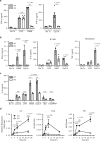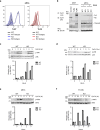An essential role for TASL in mouse autoimmune pathogenesis and Toll-like receptor signaling
- PMID: 39856038
- PMCID: PMC11760370
- DOI: 10.1038/s41467-024-55690-0
An essential role for TASL in mouse autoimmune pathogenesis and Toll-like receptor signaling
Abstract
TASL is an immune adaptor that binds to the solute carrier SLC15A4 and facilitates activation of the transcription factor IRF5 during Toll-like receptor (TLR) signaling. Similar to IRF5 and SLC15A4, single nucleotide polymorphisms (SNPs) within TASL have been implicated in increased susceptibility to systemic lupus erythematosus (SLE) in patients. However, the biological function of TASL in vivo and how SLE-associated SNPs increase disease risk is unknown. Here we report that mice deficient in Tasl lack responses to TLR7/9 stimulation and are protected from autoimmune symptoms induced by Aldara or pristane. Loss of Tasl reduces IRF5 phosphorylation and cytokine production in multiple immune cell types but has no effect on other aspects of TLR signaling. Conversely, an SLE-associated TASL risk variant increases TASL protein expression via codon usage, resulting in augmented cytokine production in human cells. Altogether, our study validates the essential function of TASL in TLR signaling and autoimmune pathogenesis.
© 2025. The Author(s).
Conflict of interest statement
Competing interests: All authors were employees of Amgen Inc. at time of studies. L.L, T.A.C, W.O, and P.S.M are current employees of Gilead Inc. R.H. is a current employee of Genentech Inc. A.C. is a current employee of Exelixis. D.N.B., M.J.R., J.H.L., and J.D. are current employees of Amgen Inc.
Figures




References
MeSH terms
Substances
LinkOut - more resources
Full Text Sources
Medical
Molecular Biology Databases
Research Materials

